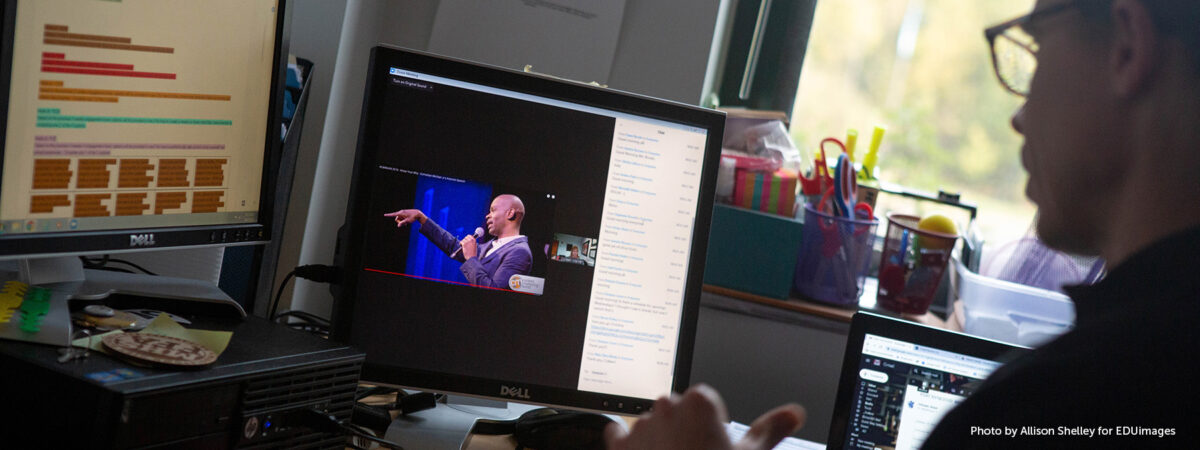
Attendees had the opportunity to learn about the latest educational trends, emerging technologies, and innovative strategies shaping education directly from education and edtech experts like Girls Who Code founder Reshma Saujani; Future Ready Schools director of innovation Tom Murray; 2023 National Teacher of the Year Rebecka Peterson; Class Tech Tips founder Dr. Monica Burns; and Cult of Pedagogy editor-in-chief Jennifer Gonzalez.
Two educators who spent the day with us reflected on their takeaways and shared how they are applying their learnings in the classroom:

The 2023 Elevating Innovation Virtual Conference had many amazing presenters who left a lasting impact, but Reshman Saujani’s session really resonated with me. Reshma urged us to build for the most vulnerable because by doing that we will be designing for everybody. This reminds me of “The Myth of Average” TED Talk by Todd Rose, who challenged us to design for the edges. The vulnerable are those students at the edges.
Imagine if we designed learning experiences for these students. Imagine if edtech providers designed products for them. For me, this means embedding Universal Design for Learning (UDL) into my learning experiences and asking questions while I am designing: Is this accessible? Do my learners have choices in each stage of the learning process? Are there supports in place so that my learners feel safe pushing themselves and taking risks?
Reshma also emphasized how generative artificial intelligence (AI) will help level the playing field IF everyone has access to it. “Yes, there are risks, but it’s here,” she said. “It’s been here awhile. So how do we learn from our mistakes in the past?”
This is such a crucial point as we think about the tech inequities in education, such as the lack of access to high-speed internet, quality devices, and software. If we want to utilize generative AI as a tool to help our students, we need to ensure that we provide ALL of them with the tools and time to learn how to harness its abilities.
Jennifer Gonzalez’s presentation, “Next-Level Edtech: Are We Thinking Big Enough?,” also resonated with me. She outlined different pathways educators might explore with our students through edtech, including storytelling, students teaching others, making, marketing, philanthropy, and community support. The common thread through all of the pathways is students harnessing technology to share their voices past the four walls of the classroom.
Edtech has democratized access to so many tools for creativity and communication for our students. By incorporating these real-world applications into our teaching and helping students see the impact of their work on others, I believe they will be inspired to innovate beyond what any of us can imagine.
 Abigail Thompson, Digital Learning Coach, Kansas City, Missouri
Abigail Thompson, Digital Learning Coach, Kansas City, Missouri“Students have more choice with their dinner than education.”
This quote from Chris Bronke of Novak Education, the facilitator of the “Shift to Student Led” session at Elevating Innovation, is still resonating with me weeks after attending. I work in an International Baccalaureate (IB) Verizon Innovative Learning School that believes in the importance of students taking charge of their own learning, which made this session the perfect fit for us.
The session left me not only with innovative ideas to share with our teachers, but also with the information needed to show why this is the shift we must strive for. We talked about the five drivers of student-led learning and how this should be the guide to building learning experiences.
In my coaching practices, I am beginning to share these essential components of student-led learning with my teachers so together we can unwrap how to improve this practice in our classrooms. For example, we were also able to explore if our learning experiences are student-paced (flexible deadlines and same set of experiences) or self-directed (flexible deadlines but multiple pathways to learn).
The five drivers, coupled with choosing between student-paced and self-directed approaches, enhance our school’s ongoing professional learning efforts, allowing us to accelerate our success.
Elevating Innovation is not a conference you want to miss. There are a multitude of sessions to choose from that will align with your current school goals. It is truly a powerful learning experience!
Watch the recordings of most Elevating Innovation sessions on Verizon Innovative Learning HQ and sign up for next year’s virtual conference—information coming later this year!